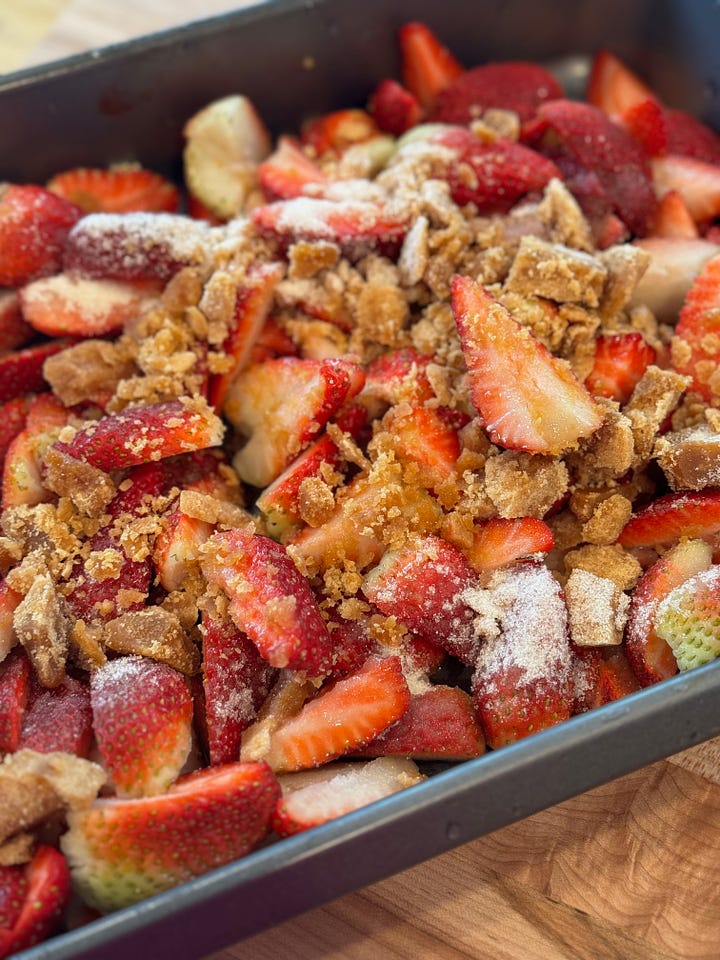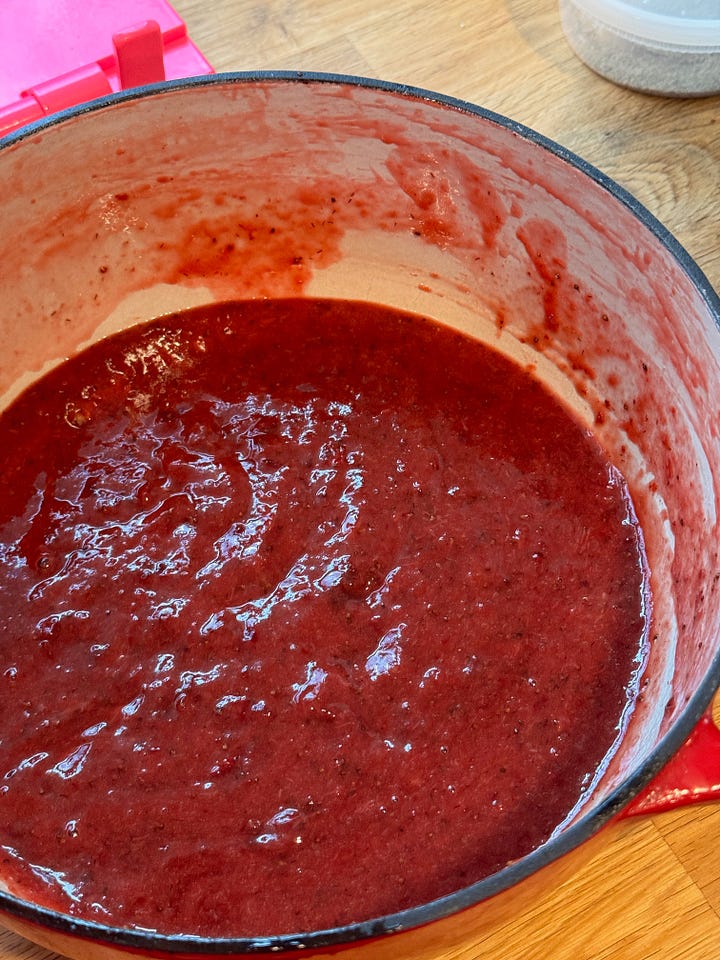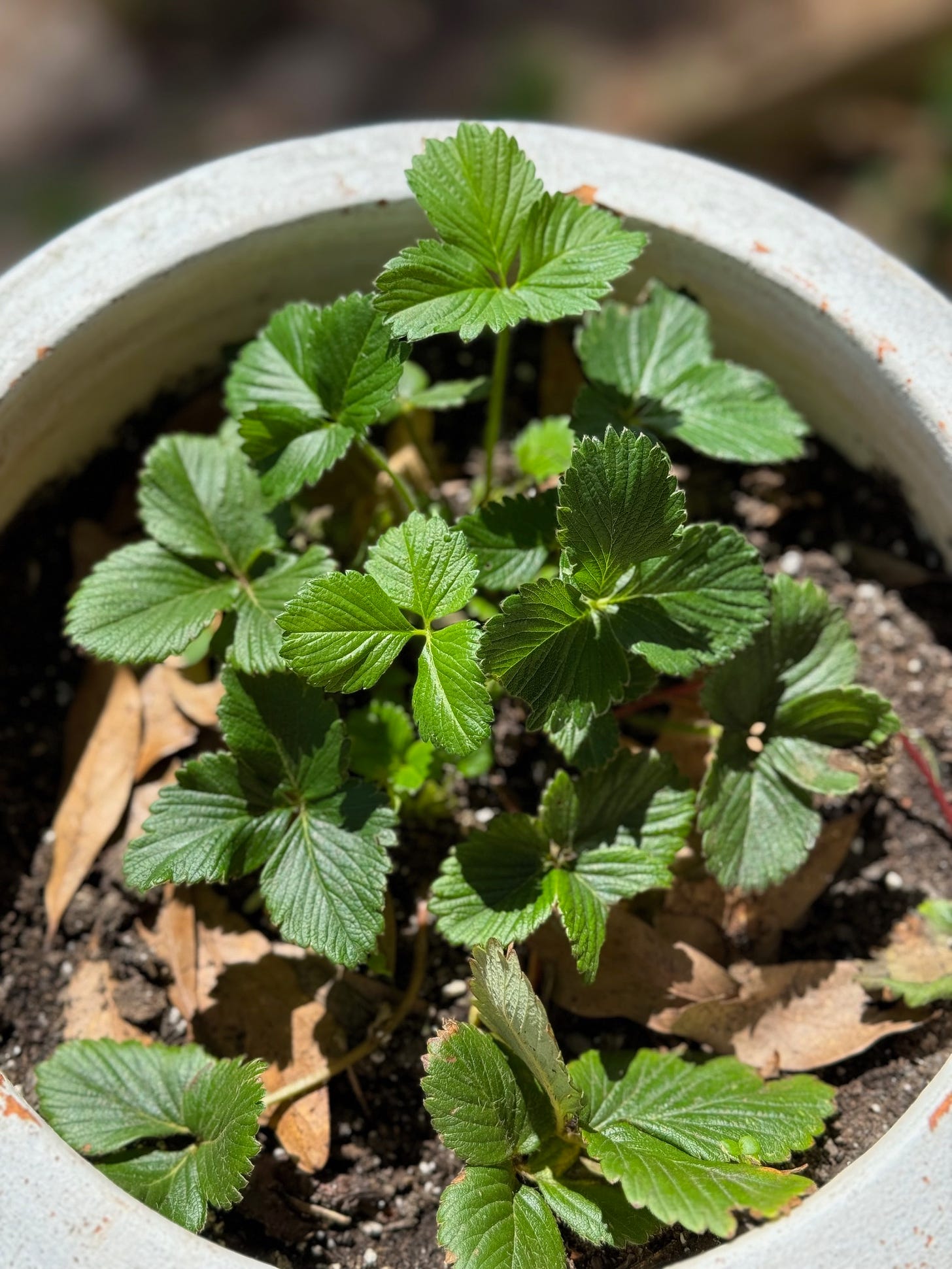In “The Gift of Strawberries” chapter of her 2013 book Braiding Sweetgrass: Indigenous Wisdom, Scientific Knowledge and the Teaching of Plants, Robin Wall Kimmerer describes a dream. In her dream she’s walking around an outdoor market attempting to purchase cilantro from her vendor friend Edita, fresh rolls from her favorite panadera—only none of the vendors are accepting her money. Everything at the market was being handed over as a gift. “It wasn’t just for me–no shopper was paying”, she writes. “I floated through the market with a sense of euphoria. Gratitude was the only currency accepted here.”
Earlier in the chapter Kimmerer writes about being raised by wild strawberries. How her and her siblings would frolic through the fields of ruby jewels behind her childhood home to pick out the best berries to use in a strawberry shortcake as a Father’s Day gift to her dad. How the sheer abundance of the fields helped to shape her vision “of a world full of gifts.”


Writing about a “gift economy” Kimmerer uses wild strawberries as an example of the true nature of a gift, a thing which through intention forms a relationship between giver and receiver. “Gifts from the earth or from each other establish a particular relationship, an obligation of sorts to give, to receive, and to reciprocate. The field gave to us, we gave to my dad, and we tried to give back to the strawberries,” she writes, going on to describe how she would remove the weeds around the runners the plant gives out at the end of the season to make way for more plants. “Because they had given us a gift, an ongoing relationship opened between us.”
Growing up in Silicon Valley I took for granted the abundance, the relationship between food and eater, Kimmerer was wise enough to appreciate. I was still too young, too ignorant to think much about the gift that was California produce, available to us year-round. Later as a young adult, after my grandparents swapped one valley for another—moving away from the crowded tech valley to the open spaces of the Central Valley farmland—I frequently visited the place that produces 1/4th of the country’s food.
I have countless memories of my grandfather driving mere minutes to Highway 33, which runs right through the Central Valley and parallel to Highway 5, eventually ending south in Ventura, to stop at any number of strawberry stands that dot the shoulder. Arriving back home with flats for the family, he and I would pick out the biggest berries for snacking. There was never any extra, nothing left for jam-making (I don’t recall anyone in my family ever making jam, actually), only for eating straight up.
In another chapter of Braiding Sweetgrass, Kimmerer writes “What would it be like, I wondered, to live with that heightened sensitivity to the lives given for ours? To consider the tree in the Kleenex, the algae in the toothpaste, the oaks in the floor, the grapes in the wine; to follow back the thread of life in everything and pay it respect? Once you start, it’s hard to stop, and you begin to feel yourself awash in gifts.”
If we follow a very specific thread from California strawberry fields to strawberry consumers nationwide, we’d land at the feet of migrant workers. In 1995 the investigative writer Eric Schlosser wrote what would later that year become an award-winning piece on the exploitation and living and working conditions of agricultural workers in California, namely those in the Central Valley. In “In the Strawberry Fields” Schlosser wrote, “The strawberry has long been known to migrants as la fruta del diablo—the fruit of the devil. Picking strawberries is some of the lowest-paid, most difficult and therefore least desirable farm work in California.”
The piece is full of details of the brutal reality for the migrant workers responsible for carrying the California agricultural industry, including a link to a 1985 Los Angeles Times piece on Central Valley strawberry farm workers living in caves, among other horrors. Having a heightened awareness of this exchange between giver and receiver is a nice idea, a good starting point. In the case of strawberries–and all food–we have to follow the thread of life further, all the way to the fields, if we really wish to live in gratitude to the lives impacted and taken from our consumption.

Growing up I heard over and over the stories of field work that is enmeshed with my own family history. Leaving Jalisco, MX—land of mariachi and tequila— in the ‘50s for the agricultural fields of California, my great-grandfather, along with my grandpa and all of his 15 siblings, “worked the fields” upon arrival and for years after. I was mostly sheltered from this reality; I never picked a thing nor spent any time in the fields directly. My only experience of the brutality of field work was through story and as a threat of punishment. My mom would routinely tell my sister and brother and I to shape up, lest she send us off to some time in the fields with great-grandpa.
Now as an adult living 2,500 miles away from California soil I work with ingredients when they taste best, in their seasons. My repeat bakery customers understand I don’t make strawberry cakes in the middle of October, no matter that the berries are still lingering in grocery store produce sections, fresh off the plane from California. The best way I know how to work with strawberries aside from just popping them whole in my mouth like I did with my grandfather, is to slow-roast.
Slow-roasting deepens a strawberry’s flavor. I like to purée the berries once they’ve cooled with an immersion blender, and from there use in what has become the most popular cake at my bakery in the spring, the Strawberry on Strawberry cake. The purée can also be used as an addition to your morning smoothie, spooned over ice cream or into swiss meringue buttercream.
Set your oven to 350F and plan to roast the berries for upwards of two hours. Remove the green tops from a pound of strawberries with a small paring knife, then angle the knife where the greens were to hull the berry without slicing away too much of the flesh (reserve the edible green tops for compost or candy them to use for decoration on strawberry desserts).
Think of the hands working the fields, hands that sliced the strawberry stem from its red runner and arranged into as many 16-ounce plastic containers as humanly (as inhumanely) possible.
Plop the berries into a baking dish, something with high sides to contain the juices that will release as the strawberries roast. Sprinkle 1/2 cup of your choice of sweetener—cane sugar, brown sugar or piloncillo—and the zest and juice from one big lemon or two smaller lemons and toss to disperse the sugar and acid amoung the berries.
As the berries roast think of the scorching California sun, the working conditions that no one should have to live through or accept as is, the triple digit temperatures that, because of climage change, have now become the norm during strawberry season. Remember the migrant workers who suffered to get produce on tables across the country. Give thanks for having access to strawberries and consider giving what you can to farm worker advocacy groups like California Farmworker Foundation, or a grassroots organization based out of Los Angelels and run by a Twitter mutual back when I still had Twitter, Polo’s Pantry.







A little late but love the “ingredient feature”concept. Finally made it and looking forward to using it!